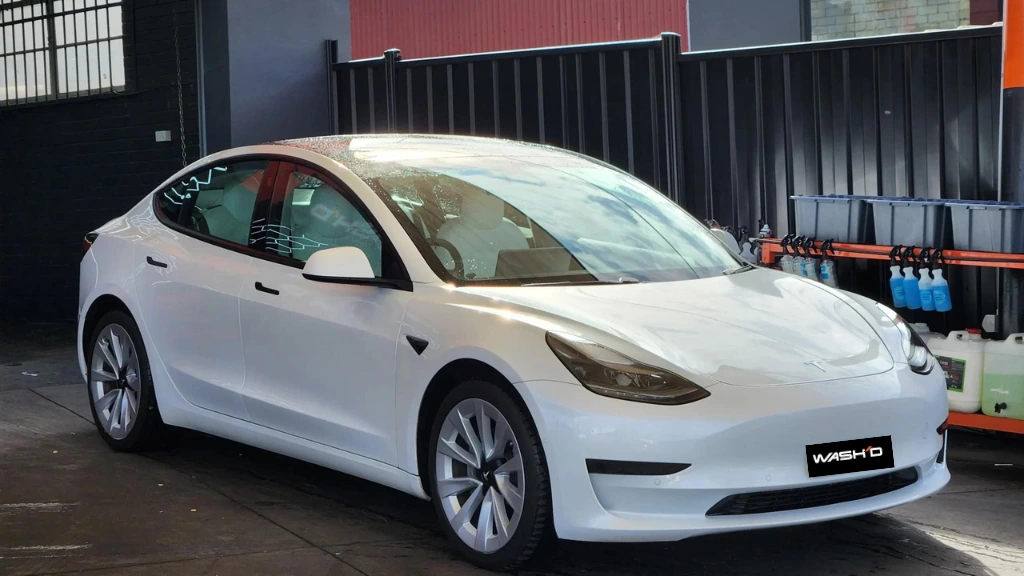As electric vehicles (EVs) continue to gain popularity in Melbourne, owners are seeking ways to optimise their performance and efficiency. We will dive into our comprehensive guide on the benefits of Ceramic Coating Melbourne for EVs and discover the key to preserving and enhancing your vehicle’s aesthetic and functional appeal
How Ceramic Coating Melbourne Affects Electric Cars
When it comes to protecting your electric car, Ceramic Coating Melbourne is a game changer. This innovative solution not only enhances your vehicle’s appearance with a glossy finish but also shields it from harmful environmental elements.
With its hydrophobic properties, the Ceramic Car Coating makes cleaning a breeze, ensuring your electric car stays sleek and spotless. Plus, it adds an extra layer of protection against scratches and contaminants, keeping your investment looking brand new for years to come.
To understand the impact of Ceramic Coating on (EVs), let’s examine the key factors:
- Aerodynamics: Ceramic Coating has a negligible effect on aerodynamics. The coating’s thickness doesn’t alter the vehicle’s shape or airflow.
- Weight: The weight of Ceramic Coating is minimal (approximately 100-200 grams). This insignificant weight increase doesn’t affect the EV’s overall weight or efficiency.
- Heat Management: Ceramic Coating can help reduce the heat buildup on the vehicle’s surface. However, this doesn’t directly impact the EV’s battery or motor efficiency.
- Electrical Resistance: Ceramic Coating is an electrical insulator, but its impact on EVs is minimal. The coating doesn’t interfere with the vehicle’s electrical systems or charging efficiency.
Why Ceramic Coating Melbourne For Evs Is The Future
Electric Vehicles (EVs) are not just a passing trend; they are the future of automotive transportation.
As EV adoption rates increase rapidly, so does the need to understand and invest in the best protection for these marvels of modern engineering. That’s where EV Ceramic Coating Melbourne enters the scene.
Is Ceramic Coating Melbourne recommended for Tesla?
Many drivers are curious about whether Ceramic coating can impact range or efficiency in electric cars like Tesla. While Ceramic Coating doesn’t directly boost a vehicle’s performance, it offers several benefits that can enhance the overall driving experience.
First, the Ceramic Car Coating Melbourne provides a protective layer that keeps your Tesla looking pristine. This coating makes your car more resistant to dirt, grime, and even minor scratches, which means you can spend less time cleaning and more time enjoying the drive. A cleaner vehicle can help maintain its aerodynamic design, reducing drag and possibly improving efficiency—especially during highway travel.
In short, Ceramic Coating Melbourne is an intelligent investment for Tesla owners looking to protect their vehicles. It enhances aesthetic appeal and aids in efficiency. It helps maintain that impressive range, making each journey not just about getting from point A to point B but also about enjoying the ride along the way.
Is Ceramic Coating recommended for other electric vehicle brands?
Absolutely! Ceramic Coating Melbourne is highly recommended for a variety of electric vehicle brands, not just Tesla. Whether you drive a Nissan Leaf, Hyundai Kona Electric, or a Ford Mustang Mach-E, this protective layer can enhance your car’s appearance and shield it from environmental damage. By keeping your vehicle cleaner and more aerodynamic, ceramic coating helps maintain efficiency and extend the life of your car’s exterior. It’s a wise investment for any electric car owner looking to protect their ride!
Some critical considerations for Ceramic Coating application on electric vehicles
Applying ceramic coatings to electric vehicles requires careful attention due to their unique nature and sensitive electrical components. Unlike traditional cars, EVs incorporate batteries, wiring, and sophisticated electronic systems. Any oversight during coating could interfere with these components, impacting performance and safety.
Here are some critical considerations for the Ceramic Coating Melbourne application.
- Electrical Components: Electric vehicles contain intricate electrical systems crucial for their operation. Coating these components can potentially disrupt signals or cause overheating, leading to malfunctions or safety hazards. Therefore, it’s essential to avoid coating areas like batteries, wiring, and electronic control units to maintain the integrity and functionality of the electrical systems.
- Heat Management: Heat management is critical in electric vehicles, particularly concerning the battery and motor. Ceramic coatings should not hinder heat management from these components, as excessive heat buildup can degrade performance and reduce battery life. Ensuring proper thermal management preserves the efficiency and longevity of the vehicle’s powertrain.
- Weight Impact: Electric vehicles prioritise lightweight construction to maximise energy efficiency and driving range. Applying ceramic coatings excessively can add unnecessary weight, potentially compromising efficiency. Choosing lightweight ceramic coatings and applying them sparingly helps mitigate any adverse effects on the vehicle’s weight and energy consumption.
- Environmental Impact: Environmental sustainability is a critical consideration in electric vehicle design and maintenance. Some ceramic coatings may contain harmful chemicals or emit volatile organic compounds (VOCs), posing risks to the environment. Choosing eco-friendly ceramic coatings minimises environmental impact during application and throughout the coating’s lifespan, aligning with the eco-conscious ethos of electric vehicles.
- Compatibility with Materials: Electric vehicles incorporate various materials in their construction, including paint, glass, plastics, and metals. Ceramic coatings should be compatible with these materials to avoid adverse reactions or damage.
- Electromagnetic Interference (EMI): Electric vehicles rely on sophisticated electronics for driving, communication, and safety features. Coatings that generate electromagnetic interference (EMI) can disrupt these systems, leading to malfunctions or compromised performance. Choosing ceramic coatings that do not interfere with electronic signals preserves the reliability and functionality of onboard electronics.
- Charging Port Protection: The charging port is a vital interface for replenishing an electric vehicle’s battery. Accumulation of ceramic coating residue around the charging port can obstruct proper connectivity, potentially causing charging failures or safety hazards.
- Longevity and Maintenance: Electric vehicle owners seek durable and low-maintenance solutions to protect their investments. Properly maintained Ceramic Coating Melbourne maintains their effectiveness over time, reducing the need for frequent reapplications and minimising vehicle owners’ maintenance efforts.
FAQS
What is ceramic coating?
Ceramic coating is a protective layer applied to your car’s exterior that helps repel dirt, water, and other contaminants, keeping your vehicle looking shiny and new.
Does ceramic coating improve my electric car's range?
While the ceramic coating doesn’t directly enhance range, it can help maintain a cleaner, smoother surface that may improve aerodynamics, potentially leading to slight efficiency gains during drives.
How does a clean surface affect efficiency?
A clean, smooth surface reduces drag, which means your electric vehicle can glide through the air more efficiently. This can help maximise your battery’s performance, especially on long trips.
Will ceramic coating protect my Tesla from environmental damage?
Absolutely! Ceramic coating provides a barrier against UV rays, dirt, and contaminants, protecting your paint job and helping to preserve your car’s value over time.
Can ceramic coating affect battery performance?
Ceramic coating won’t impact the battery itself, but protecting your car’s exterior from extreme temperatures can help create a more stable environment for your vehicle overall.
Is ceramic coating worth the investment in EVs?
Many Tesla and EV owners find that the benefits—like enhanced protection, reduced maintenance, and potential efficiency gains—make ceramic coating a worthwhile investment for their vehicles.
How long does ceramic coating last on electric vehicles?
With proper care, ceramic coating can last for several years, providing ongoing protection and helping to keep your electric car looking its best for the long haul.
Should I consider ceramic coating if I drive a lot?
If you frequently drive your electric vehicle, especially in varying weather conditions, ceramic coating can be an intelligent choice. It helps maintain the exterior and can make cleaning much more accessible, allowing you to enjoy your ride without the hassle.
Conclusion
Although Ceramic Coating Melbourne doesn’t directly increase the range of your electric car, it plays a valuable role in maintaining efficiency and appearance. By reducing drag and making cleaning easier, the coating helps you get the most out of every charge, ensuring your ride remains as enjoyable as it is stylish.


